人教版七年级下册英语Unit6导学案
- 格式:doc
- 大小:104.00 KB
- 文档页数:12
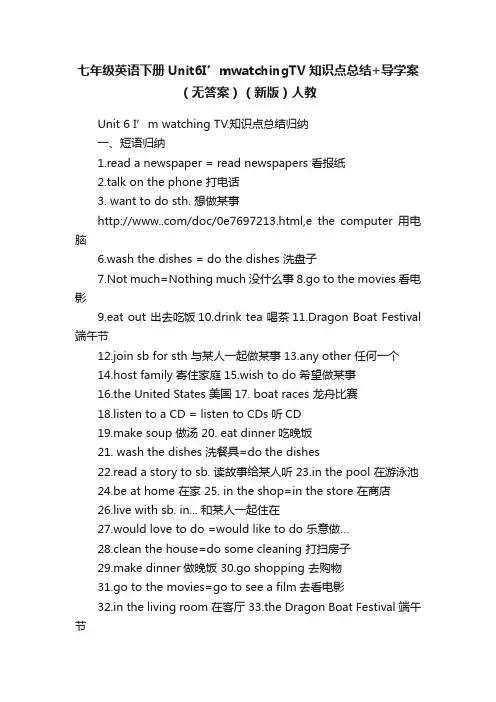
七年级英语下册Unit6I’mwatchingTV知识点总结+导学案(无答案)(新版)人教Unit 6 I’m watching TV.知识点总结归纳一、短语归纳1.read a newspaper = read newspapers 看报纸2.talk on the phone 打电话3. want to do sth. 想做某事/doc/0e7697213.html,e the computer 用电脑6.wash the dishes = do the dishes 洗盘子7.Not much=Nothing much 没什么事8.go to the movies 看电影9.eat out 出去吃饭10.drink tea 喝茶11.Dragon Boat Festival 端午节12.join sb for sth 与某人一起做某事13.any other 任何一个14.host family 寄住家庭15.wish to do 希望做某事16.the United States 美国17. boat races 龙舟比赛18.listen to a CD = listen to CDs听CD19.make soup 做汤 20. eat dinner吃晚饭21. wash the dishes 洗餐具=do the dishes22.read a story to sb. 读故事给某人听 23.in the pool 在游泳池24.be at home 在家 25. in the shop=in the store 在商店26.live with sb. in... 和某人一起住在27.would love to do =would like to do 乐意做…28.clean the house=do some cleaning 打扫房子29.make dinner做晚饭 30.go shopping 去购物31.go to the movies=go to see a film去看电影32.in the living room 在客厅 33.the Dragon Boat Festival 端午节34.in the supermarket 在超市35.in the library 在图书馆36. on the playground 在操场37. in the United States=in the US 在美国38. watch the boat race on TV 在电视上看龙舟比赛39.write a letter写一封信 40. thanks for sth. 为... ...而感谢41.a picture of my family 一张我家的照片42.host family 房东家43. read ... sb.读... ...给某人听44. want to do sth. 想做某事45.see you tomorrow 明天见46.swim in a pool 在游泳池里游泳47.make zongzi 包粽子 48. the night before 前一天夜里49. watch... on TV 在电视上看 ... ... 50. talk show 脱口秀二、用法集萃1. --What +be+主语+doing? ... ...正在做什么?--主语+be+doing sth. ... ... 正在做某事。
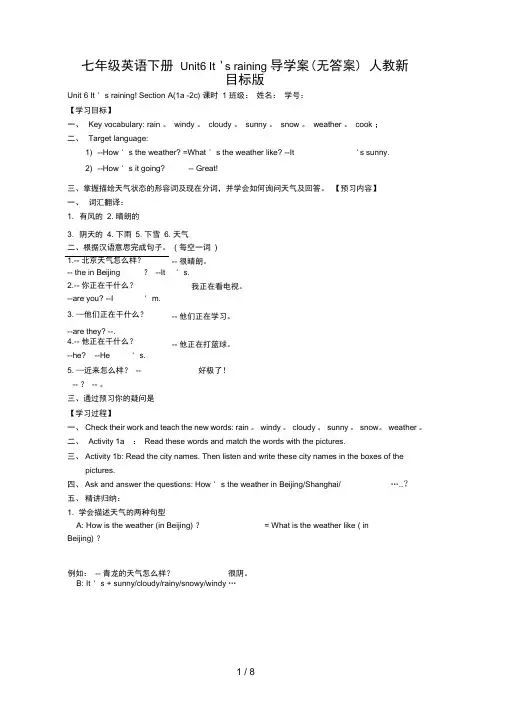
七年级英语下册Unit6 It 's raining 导学案(无答案) 人教新目标版Unit 6 It ' s raining! Section A(1a -2c) 课时1 班级:姓名:学号:【学习目标】一、Key vocabulary: rain 。
windy 。
cloudy 。
sunny 。
snow 。
weather 。
cook ;二、Target language:1) --How ' s the weather? =What ' s the weather like? --It 's sunny.2) --How ' s it going? -- Great!三、掌握描绘天气状态的形容词及现在分词,并学会如何询问天气及回答。
【预习内容】一、词汇翻译:1. 有风的2. 晴朗的3. 阴天的4. 下雨5. 下雪6. 天气二、根据汉语意思完成句子。
( 每空一词)1.-- 北京天气怎么样?-- 很晴朗。
-- the in Beijing ?--It ' s.2.-- 你正在干什么?-我正在看电视。
--are you? --I ' m.3. —他们正在干什么?-- 他们正在学习。
--are they? --.4.-- 他正在干什么?-- 他正在打篮球。
--he? --He ' s.5. —近来怎么样?-- 好极了!-- ?-- 。
三、通过预习你的疑问是【学习过程】一、Check their work and teach the new words: rain 。
windy 。
cloudy 。
sunny 。
snow。
weather 。
二、Activity 1a :Read these words and match the words with the pictures.三、Activity 1b: Read the city names. Then listen and write these city names in the boxes of thepictures.四、Ask and answer the questions: How ' s the weather in Beijing/Shanghai/ …..?五、精讲归纳:1. 学会描述天气的两种句型A: How is the weather (in Beijing) ?= What is the weather like ( inBeijing) ?B: It ' s + sunny/cloudy/rainy/snowy/windy …例如:-- 青龙的天气怎么样?很阴。
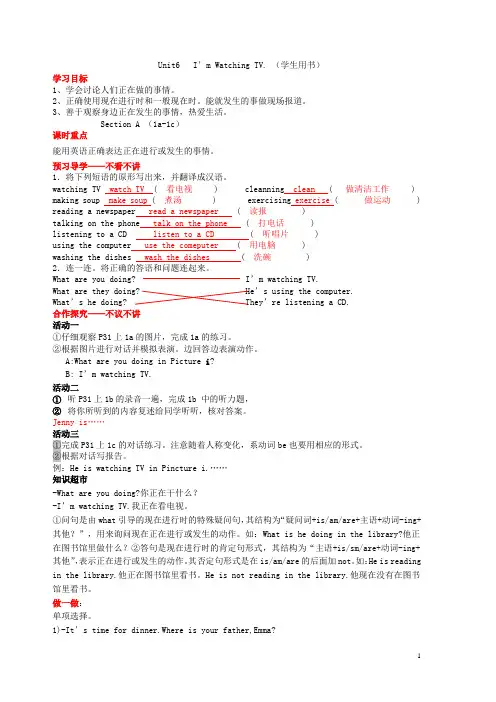
Unit6 I’m Watching TV. (学生用书)学习目标1、学会讨论人们正在做的事情。
2、正确使用现在进行时和一般现在时。
能就发生的事做现场报道。
3、善于观察身边正在发生的事情,热爱生活。
Section A (1a-1c)课时重点能用英语正确表达正在进行或发生的事情。
预习导学——不看不讲1.将下列短语的原形写出来,并翻译成汉语。
watching TV watch TV ( 看电视 ) cleanning clean ( 做清洁工作 ) making soup make soup ( 煮汤 ) exercising exercise ( 做运动 ) reading a newspaper read a newspaper ( 读报 )talking on the phone talk on the phone ( 打电话 )listening to a CD listen to a CD ( 听唱片 )using the computer use the comeputer ( 用电脑 )washing the dishes wash the dishes ( 洗碗 )2.连一连。
将正确的答语和问题连起来。
What are you doing? What are they doing? What’s he doing? I’m watching TV.He’s using the computer. They’re listening a CD.合作探究——不议不讲活动一①仔细观察P31上1a的图片,完成1a的练习。
②根据图片进行对话并模拟表演。
边回答边表演动作。
A:What are you doing in Picture i?B: I’m watching TV.活动二①听P31上1b的录音一遍,完成1b 中的听力题,②将你所听到的内容复述给同学听听,核对答案。
Jenny is……活动三①完成P31上1c的对话练习。
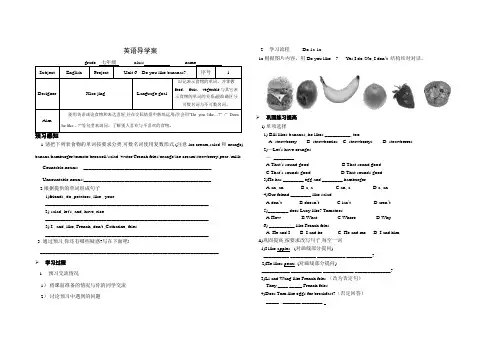
英语导学案1.请把下列表食物的单词按要求分类,可数名词使用复数形式.(注意ice cream,salad和orange)banana/hamburger/tomato/broccoli/salad /water/French fries/orange/ice cream/strawberry/pear /milkCountable nouns: __________________________________________________Uncountable nouns:__________________________________________________2.根据提供的单词组成句子1)friends, do, potatoes, like , your________________________________________________________________2) salad, let's, and, have, rice________________________________________________________________3) I , and, like, French, don't ,Catharine, fries________________________________________________________________3 .通过预习,你还有哪些疑惑?写在下面吧!______________________________________________________________________学习过程1.预习交流情况1)将课前准备的情况与你的同学交流2)讨论预习中遇到的问题2.学习流程Do 1a-1c1c.根据图片内容,用Do you like ...? Yes,I do./No, I don’t .结构结对对话。
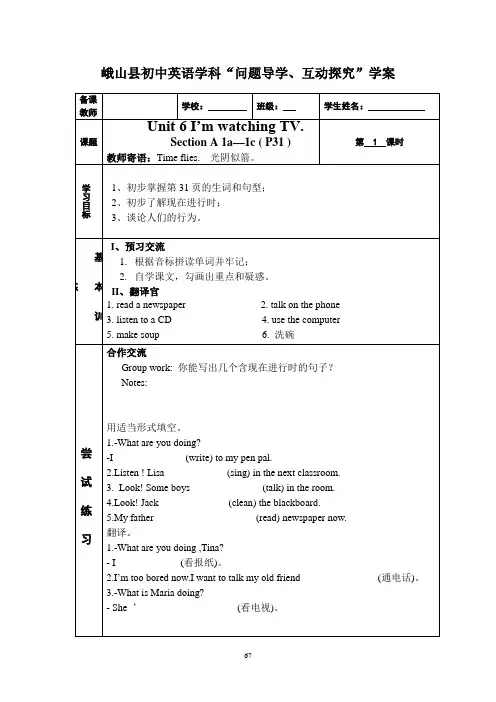
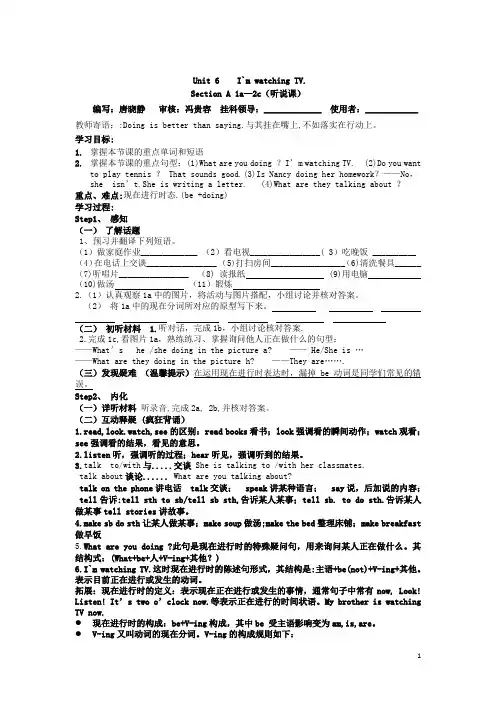
Unit 6 I`m watching TV.Section A 1a—2c(听说课)编写:唐晓静审核:冯贵容挂科领导:_____________ 使用者:____________ 教师寄语::Doing is better than saying.与其挂在嘴上,不如落实在行动上。
学习目标:1.掌握本节课的重点单词和短语2.掌握本节课的重点句型:(1)What are you doing ?I’m watching TV. (2)Do you wantto play tennis ? That sounds good.(3)Is Nancy doing her homework?——No,she isn’t.She is writing a letter. (4)What are they talking about ?重点、难点:现在进行时态.(be +doing)学习过程:Step1、感知(一)了解话题1、预习并翻译下列短语。
(1)做家庭作业_____________ (2)看电视________________( 3)吃晚饭 __________(4)在电话上交谈________________ (5)打扫房间_________________(6)清洗餐具______(7)听唱片________________ (8) 读报纸 (9)用电脑(10)做汤(11)锻炼2.(1)认真观察1a中的图片,将活动与图片搭配,小组讨论并核对答案。
(2)将1a中的现在分词所对应的原型写下来。
(二)初听材料 1.听对话,完成1b,小组讨论核对答案.2.完成1c,看图片1a,熟练练习、掌握询问他人正在做什么的句型:——What’s he /she doing in the picture a? —— He/She is …——What are they doing in the picture h? ——They are…….(三)发现疑难(温馨提示)在运用现在进行时表达时,漏掉be动词是同学们常见的错误。
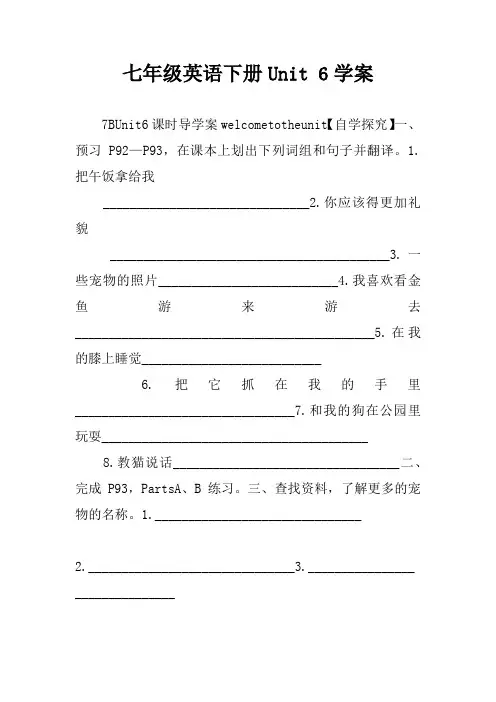
七年级英语下册Unit 6学案7BUnit6课时导学案welcometotheunit【自学探究】一、预习P92—P93,在课本上划出下列词组和句子并翻译。
1.把午饭拿给我_______________________________2.你应该得更加礼貌__________________________________________3.一些宠物的照片___________________________4.我喜欢看金鱼游来游去_____________________________________________5.在我的膝上睡觉___________________________6.把它抓在我的手里_________________________________7.和我的狗在公园里玩耍________________________________________8.教猫说话__________________________________二、完成P93,PartsA、B练习。
三、查找资料,了解更多的宠物的名称。
1._______________________________2._______________________________3.________________ _______________4._______________________________5.________________ _______________6._______________________________【教案】教学内容7BUnit6welcometotheunit课型新授课教学目标1.Tointroducestudentstotheworldofpets2.Toidentifyna mesofanimalsandtypicalfeatures3.Tounderstanddiffere ncesinanimalfeatures教学重难点1.Toidentifynamesofanimalsandtypicalfeatures2.Phras es:bringsbsthbemorepoliteswimaroundonone’slapholdsthinone’shandfeedsbsthteachsbtodosth教学方法Task-basedapproach教具准备multimedia教学步骤教师活动学生活动个性化补充StepILeading-in1.Guidestudentstorecallthenamesofsomeanim alsthattheylearnt.Askstudents:Doyoulikeawhatanimals doyouknow?Ifyoulikeananimalverymuch,youcankeepitasa petinyourflat.whatanimaldoyouwanttokeepasapet?2.Studentsgivetheanswers.StepIIPresentation1Presentstudentssomepictures,suchasacat,adog,arabbit ,agoldfish,amouse,aparrot,etc.2Talkwithstudents:1).T:whatisit?S:Itisarabbit.T:Doyo ulikeit?S:yes,Ilikeitverymuch.T:whydoyoulikeit?S:B ecauseitislovely.Ithastwolongears.Itoftenjumpsand runshereandthere.Icanfeeditcarrotswhenitishungry.Thatwillbeinteresting.2)T:what’sthis?S:It’saparrot.T:whydoyoulikeit?S:Itcanspeakandsinglikeap erson.That’swonderful!Ifeelhappywhenitiswithme.AndIcanteachit tospeak.3)T:whatdoyouthinkaboutthemouse?S:oh,itissmallandsoft .T:Icanholditinmyhand.maybesomepeopledon’tlikeit,butIthinkitissmartandlovely4)T:Ilikegoldfishverymuch,andyou?S:Ilikewatchingitswimaround.Itstailissobeau tifulwhenitisswimming.Howhappyandfreeitisinwater!5) T:Girlsusuallylikecats,butoneofmyfriendsdoesn’t.S:why?T:Itoftenlikestosleeponherlap,soshecan’tdoanything.3.Teachnewwords.StepIIITask1.EncouragestudentstodothetaskinPartAonPage932.Dividetheclassintopairs.Askstudentstocomparetheiran swersanddiscussanydisagreements.3.StudentsdoPartBasaquiz.Studentsclosetheirbooks.your eadthesentencesa-fandstudentshavetoguesstheanswer.T hestudentwhoanswersfirstgetsapoint.4.Askstudentstoprepareasentenceabouttheirfavoritepet. Tellthemtopretendthattheyhaveapetiftheydonotownone. 5.Askstudentstosharetheirsentences.StepIVPresentation1.TellstudentsEddiealsohasapet—Hobo.Listentotheirconversationandanswerthefollowin gquestion:IsHoboagoodpet?2.Playthetapeforstudentstofindtheans wer.3.PlaythetapeagainandaskwhatdoesEddiewant?Howdo esHoborespond?whyisHobounhappy?4.Playthetapeforstud entstolistenandrepeat.StepVHomework通过复习学生学过的有关宠物的词汇帮助学生激起对本单元的话题。
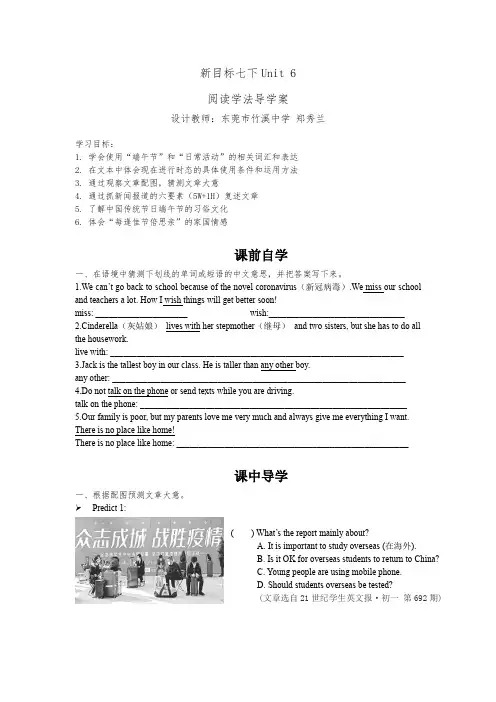
新目标七下Unit 6阅读学法导学案设计教师:东莞市竹溪中学郑秀兰学习目标:1. 学会使用“端午节”和“日常活动”的相关词汇和表达2. 在文本中体会现在进行时态的具体使用条件和运用方法3. 通过观察文章配图,猜测文章大意4. 通过抓新闻报道的六要素(5W+1H)复述文章5.了解中国传统节日端午节的习俗文化6. 体会“每逢佳节倍思亲”的家国情感课前自学一、在语境中猜测下划线的单词或短语的中文意思,并把答案写下来。
1.We can’t go back to school because of the novel coronavirus(新冠病毒).We miss our schooland teachers a lot. How I wish things will get better soon!miss: _____________________wish:_______________________________2.Cinderella(灰姑娘)lives with her stepmother(继母)and two sisters, but she has to do allthe housework.live with: ___________________________________________________________________3.Jack is the tallest boy in our class. He is taller than any other boy.any other: ___________________________________________________________________4.Do not talk on the phone or send texts while you are driving.talk on the phone: _____________________________________________________________5.Our family is poor, but my parents love me very much and always give me everything I want.There is no place like home!There is no place like home: _____________________________________________________课中导学一、根据配图预测文章大意。
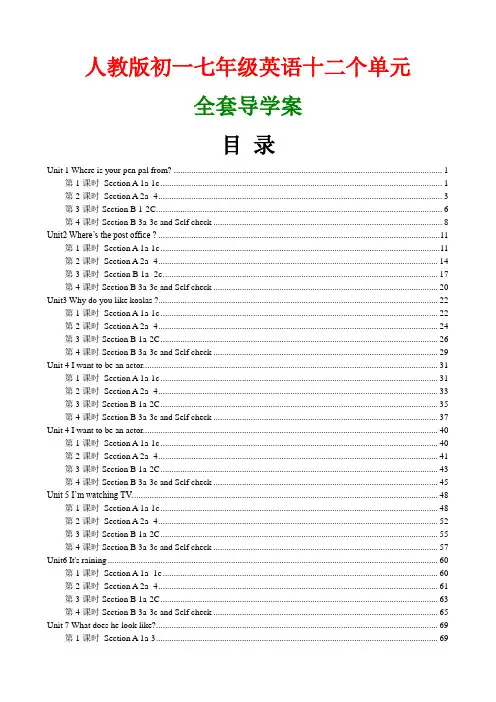
人教版初一七年级英语十二个单元全套导学案目录Unit 1 Where is your pen pal from? (1)第1课时Section A 1a-1c (1)第2课时Section A 2a -4 (3)第3课时Section B 1-2C (6)第4课时Section B 3a-3c and Self check (8)Unit2 Where’s the post office ? (11)第1课时Section A 1a-1c (11)第2课时Section A 2a -4 (14)第3课时Section B 1a -2c (17)第4课时Section B 3a-3c and Self check (20)Unit3 Why do you like koalas ? (22)第1课时Section A 1a-1c (22)第2课时Section A 2a -4 (24)第3课时Section B 1a-2C (26)第4课时Section B 3a-3c and Self check (29)Unit 4 I want to be an actor. (31)第1课时Section A 1a-1c (31)第2课时Section A 2a -4 (33)第3课时Section B 1a-2C (35)第4课时Section B 3a-3c and Self check (37)Unit 4 I want to be an actor. (40)第1课时Section A 1a-1c (40)第2课时Section A 2a -4 (41)第3课时Section B 1a-2C (43)第4课时Section B 3a-3c and Self check (45)Unit 5 I’m watching TV (48)第1课时Section A 1a-1c (48)第2课时Section A 2a -4 (52)第3课时Section B 1a-2C (55)第4课时Section B 3a-3c and Self check (57)Unit6 It's raining (60)第1课时Section A 1a -1c (60)第2课时Section A 2a -4 (61)第3课时Section B 1a-2C (63)第4课时Section B 3a-3c and Self check (65)Unit 7 What does he look like? (69)第1课时Section A 1a-3 (69)第2课时Section A 3a -4 (72)第3课时Section B 1a-2C (76)第4课时Section B 3a-3c and Self check (78)Unit 8 I’d like some noodles (83)第1课时Section A 1a-1c (83)第2课时Sectiona A 2a-4 (85)第3课时Section B 1a-2c (88)第4课时Section B 3a-4 and Self check (92)Unit9 How was your weekends? (97)第1课时Section A 1a-1c (97)第2课时Section A 2a -4 (99)第3课时Section B 1a-2C and Shelf check-3 (102)第4课时Section B 3a-3c (105)Unit 10 Where did you go on vacation? (109)第1课时Section A 1a-1c (109)第2课时Section A 3a -4 (112)第3课时Section B 1a-2C (113)第4课时Section B 3a-3c and Self check (116)Unit 11 What do you think of game shows? (119)第1课时Section A 1a-2c (119)第2课时Section A 3a -4 (123)第3课时Section B 1a-2C (125)第4课时Section B 3a-3c and Self check (128)Unit 12 Don't eat in class. (133)第1课时Section A 1a-1c (133)第2课时Section A 2a -4 (135)第3课时Section B 1a-2C (140)第4课时Section B 3a-3c and Self check (141)七年级英语下册第一单元学案Unit 1 Where is your pen pal from?第1课时Section A 1a-1c【学习目标】1. 掌握P 1 单词2.掌握句型:—Where is your pen pal from? —He is from Australia.3.掌握世界上一些国家的英文名称及地理位置。
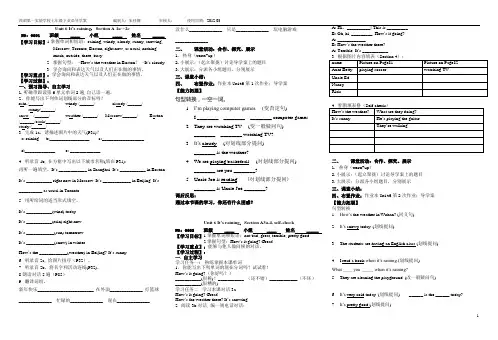
Unit 6 It’s raining. Section A 1a—2cNO: 0601 班级 ____ 小组 ____ 姓名 _____ 【学习目标】1.掌握单词和短语:raining, windy, cloudy, sunny, snowing,Moscow, Toronto, Boston, right now, as usual, nothingmuch, outside, there, busy2. 掌握句型:–How’s the weather in Boston?–It’s cloudy.3. 学会询问和表达天气以及人们正在做的事情。
【学习重点】:学会询问和表达天气以及人们正在做的事情。
【学习过程】:一、预习指导、自主学习1.听磁带跟读第6单元单词2遍,自己读一遍。
2.你能写出下列单词划线部分的音标吗?r ai n /______/ w i ndy /______/ cl ou dy /______/ s u nny/______/sn ow/______/ w ea ther /______/ M o scow/______/ B o ston/______/c oo k/______/st u dy /______/3. 完成1a,请描述图片中的天气(P31)?a: raining b:_________________ c:__________________d:_____________ e: _____________4. 听录音1b, 在方框中写出以下城市名称(填在P31):再听一遍填空。
It’s ____________ in Shanghai. It’s ___________ in Boston. It’s ___________ right now in Moscow. It’s ____________ in Beijing. It’s__________ as usual in Toronto.5. 用所给词的适当形式填空。
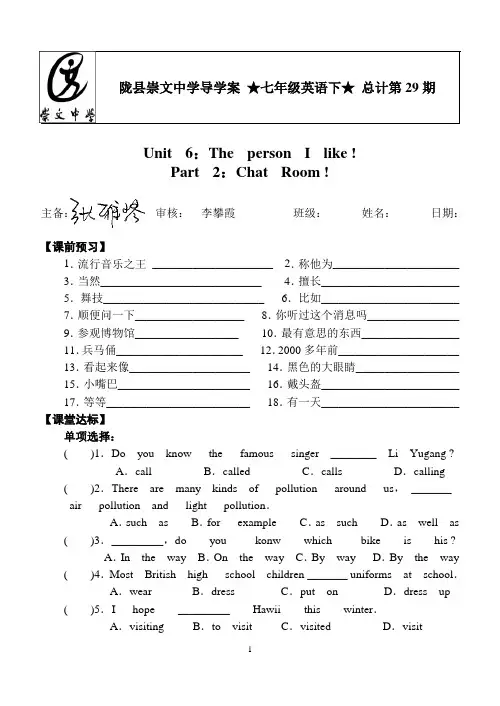
陇县崇文中学导学案★七年级英语下★总计第29期Unit 6:The person I like !Part 2:Chat Room !主备:审核:李攀霞班级:姓名:日期:【课前预习】1.流行音乐之王_____________________2.称他为______________________ 3.当然____________________________ 4.擅长________________________ 5.舞技____________________________ 6.比如________________________ 7.顺便问一下___________________8.你听过这个消息吗________________ 9.参观博物馆__________________ 10.最有意思的东西_________________ 11.兵马俑______________________12.2000多年前_____________________ 13.看起来像_____________________ 14.黑色的大眼睛__________________ 15.小嘴巴_______________________ 16.戴头盔________________________ 17.等等_________________________ 18.有一天________________________ 【课堂达标】单项选择:()1.Do you know the famous singer ________ Li Yugang ?A.call B.called C.calls D.calling ()2.There are many kinds of pollution around us,_______ air pollution and light pollution.A.such as B.for example C.as such D.as well as ()3._________,do you konw which bike is his ?A.In the way B.On the way C.By way D.By the way ()4.Most British high school children _______ uniforms at school.A.wear B.dress C.put on D.dress up ()5.I hope _________ Hawii this winter.A.visiting B.to visit C.visited D.visit1()6.They were books _________ 1,000 years ago.A.over B.at C.in D.with【课后提升】I.补全对话:A:Hi,Lily.1.__________________________B:Yes,I did.I visited a small village.A:Oh,great.2._________________________B:I took a bus.The village is a litte far.A:Did you have much fun in the village?B:Of course.I swam in the river.I also picked some pears.3.______________A:Sounds interesting.4.___________________________B:It was cloudy and cool.Did you go anywhere ?A:Yes.I went to the zoo.B:Did you see any lions ?A:No,I didn't.5.______________________ They were really cute.But I saw pandas and koalas.How was the weather there ?Did you ride a bike or take a bus there ?They tasted delicious.Did you have a trip last month ?II.根据汉语意思完成句子:1.我们通常称这只狗为旺旺。
Unit 6 I’m watching TV.Period 1 Section A 1a-2d【课型】听说课学习目标1.掌握现在进行时态及一些表示具体动作的词组搭配,如:doing homework,watching TV,eating dinner等。
2.用现在进行时的各种形式进行准确的描述和表达正在发生的动作。
学习过程【自主学习】A.预习生词,做到会读知意。
B.知识点拨:一、现在进行时表示现在(说话瞬间)正在进行或发生的动作,也可表示当前一段时间内的活动或现阶段正在进行的动作。
是由助动词be(am,is,are)+动词-ing形式构成的。
—What are you doing?—I’m doing homework.二、仔细观察,把下列动词-ing的变化形式归类。
do-doing go-going look-lookingwatch-watching read-reading eat-eatingcome-coming have-having write-writingdance-dancing run-running swim-swimming(1)(2)(3)C.预习检测:完成1a并翻译其中短语。
(1)making soup(2)watching TV(3)cleaning(4)exercising(5)reading a newspaper(6)talking on the phone【新课导入】Step 1:Lead-inLook at a picture of a boy playing basketball and answer “What’s Jim doing?” Describe the picture “He is playing basketball.” Talk about other pictures “What’s...doing?”Write the complete questions and answers.【新知呈现】Step 2:Presentation1.Look at the pictures of 1a.“Some of our friends are living in a building.What are they doing?”Answer some questions according to the pictures one by one “What is he/she doing?What are they doing in Picture h?” When the students answer the questions,the teacher writes the new words on the blackboard,for example:making soup,washing the dishes,using the computer,reading a newspaper.2.Finish the task of 1a.You can speak out the complete sentences to check the answers.【新知学习】Step 3:Listening 1bBefore listening1.Find the verb,and write the present participle,for example:watch-watching,clean-cleaning,read-reading.2.Read the requirement of 1b,and guess the people of 1a:Who’s Bob?Who’s Jenny?Who’s John?Who are Dave and Mary?While listening1.Listen to the tape and finish this task.Check the answers.Ask and answer the information,for example:A:What’s Jenny doing?B:She’s watching TV.A:What’s John doing?B:...A:What are Dave and Mary doing?B:...2.Listen again and read after it.Step 4:Pair work:1c任务1:Practice the conversation in 1b in pairs.任务2:Role-play the conversation.观察与思考1现在进行时表示正在进行的动作或存在的状态。
2019-2020学年人教版英语七年级下册全单元导学案+练习题Unit 6 I’m watching TV.语法部分安全警示:活动课上注意安全。
教学内容:P112、P113课前对话:谈论人们的活动。
教学目标:1、掌握现在进行时的用法。
2、(1)学会动词变现在分词。
(2)掌握现在进行时的构成。
3、能区分现在进行时和一般现在时。
复习旧知:1、I usually get up at 7:00 in the moring.(否定句)2、She does homework every day .(一般疑问句)3、They walk to school.(对画线部分提问)4、我的姐姐每天都帮我打扫房间。
预习导学:一、看书112页,学习现在进行时。
现在进行时表示:1、2、二、现在进行进构成:三、现在进行时变换形式:1、变一般疑问句:回答:2、变否定句:3、提问:四、与现在进行时连用的词和短语:预习检测:一、写出下列词的现在分词形式:Go ask look listentake make write getrun swim sit come二、句型转换:1. My sister is doing her homework..(一般疑问句)2. I am watching TV.(否定句)3. He is riding his bike.(提问)4. They are cleaning classroom. (一般疑问句回答)认真观察以上句子,回答问题:1、左栏中例句中谓语部分的结构与右栏例句中的谓语结构有何不同?2、两栏例句中各使用的时间状语有何不同?4、这两栏例句各表达什么概念?作业:完成导航第一课时Unit 6 I’m watching TV.语法部分练习一、用动词的正确时态填空:1. Look! The boys (play) basketball on the playground.2. My father (read) books after dinner.3. In the morning , Mr. Smith (get) up at seven o’clock.4. Listen! Linda (sing) in the next room .5. His brother usually (do) homework at school.6. They (go ) shopping every Friday evening.7. A: What’s Granpa doing now?B: He (work) in the garden.8. Her sister (eat) dinner now.9. Miss King often (wash) dishes in the evening.10. On weekends Aunt Beth (walk) with her pet dog.二、选择填空( )1.I am ____ my homework now.A doingB to doC to do myD do my( )2.____you____the blackboard?Yes,I am. A Can, clean B Am, cleaning C Are, cleaning D Do, clean( )3.______go and help her.A Let's meB Let's usC Let'sD Let's to( )4.What are they doing? They are____things .A cleanB cleaningC cleanningD cleans( )5.Do they have a new car? Yes,_____.A they areB they haveC they don'tD they do( )6.He often _________ dinner at 6:00 in the evening.A. haveB. has c. is having D. is eating( )7. It’s 6 o’clock in the morning. He ______.A. get upB. gets upC. is geting upD. is getting up( )8. What are you doing? I’m __________ TV.A. watchB. watchesC. to watchD. watching ( )9. We _______ any Chinese classes on Friday.A. are havingB. aren’t havingC. don’t haveD. are h ave( )10. Tom _______ an English class now.A. is havingB. hasC. havingD. have( )11. Are you playing basketball? No, we ___________.A. isn’tB. aren’tC. notD. don’t( )12. Listen! The girl _____________ in the room.A. singsB. singingC. is singingD. are singing( )13. The boy is __________ to his teacher.A. sayingB. speakingC. talkingD. telling( )14. I’m ___________ a book in the room.A. watchingB. seeingC. readingD. looking( )15. Where _________ he _________ from?A.is, comeB. do, comeC. does, comeD. is , from三、按要求变换句型:1、He is doing his homework now.(变一般疑问句并回答。
Unit 6 I'm watching TV.第四课时Section B (3a一女)& self check导学设计:1.Here is a picture of my family.【归纳】(1) of短语表示与名词所有格一样,表示物品的归属。
This is a map of China.这是一张中国地图。
(2)picture 意为同义词有photo“照片"、painting“绘画”。
Look at the picture on Page 5.请看第五页上的图画。
2.Tm doing my homework.我正在做作业。
【归纳】do one's homework意为one飞表示“某人的”,要与句子的主语或宾语保持一致。
He is doing his homework at home.他正在家做作业。
3.My parents are watching TV in the living room.我的父母正在客厅看电视。
【归纳】living room意为含room的单词或短语有:bedroom 卧室bathroom 浴室restroom 公共厕所washing room 盥洗室art room 美术室We are all at home now.我们现在都在家。
【归纳】home意为“家”,在此处是名词。
home还可作,前面不接介词,可与动词连用。
This is the way to my home.这是一条通向我家的路。
He goes home late.他经常回家很晚。
4.辨析supermarket, store 与shop(1)supermarket意为指自选市场,往往比store和shop都大,经营时间比较长。
The supermarket is so near my house.这家超市离我家如此近。
(2)store和shop都有“商店、商场”的意思。
Unit 6 Do you like bananas?第3课时SectionB (1a-2a)【预习目标】1. Master new words(掌握新单词):P341a2. 主语是单数第三人称时,谓语动词要有变化。
【预习重难点】1. Master the use of “like” in general and special question sentences(.掌握like在一般疑问句和特殊疑问句中的用法)2. 注意当主语是单数第三人称时动词的变化规则。
【学法指导】通过已学音标拼读生词。
搞好1a中食物的读法和汉语意思,为听力做好充分准备。
【知识链接】Let the students report their food surveys(让学生汇报他们的食物调查报告)【问题探究】一.翻译①大米②沙拉③鸡蛋④苹果⑤水果⑥汉堡⑦香蕉⑧桔子⑨胡萝卜⑩鸡肉二.Pairwork完成1b中的任务fruits:vegetables:三.Group Work认真听听力内容,然后写出Sally和Tom两人喜欢和不喜欢的食物,(食物可以自己补充)可以用以下句式:Sally likes ……,but she doesn’t like …… .Tom likes ……,but he doesn’t like …….写出下列句子的一般疑问句,肯定、否定回答、否定句。
I like bananas.Tom likes ice-cream.【检测反馈】一、句型转换,每空一词。
1. My brother likes tomatoes. (改为否定句)My brother ______ ______ tomatoes.2. Do you like milk and salad? (作否定回答)No, ______ _______.3. Mary likes apples for breakfast. (对画线部分提问)_______ does Mary _______ for breakfast?4. They have some oranges. (用he 作主语改为单数句子)He ______ ______ orange.5. Kate often eats pears. (改为一般疑问句)______ Kate often ______ pears?二、选择1. Most boys ___________ hamburgers .A. likesB. likeC. doesD. do2. Do ___________like French fries?A. heB. sheC. themD. you3. My mother ____________oranges and strawberries.A. don't likeB.do likesC. doesn't likeD. doesn't likes4. Do they like saladi ?A. Yes , I doB. Yes , they doC. No , I don't D No , they do5. There is some _________in the bag .A. appleB. saladC. tomatoD. banana。
Unit 6It’s raining!导学案Designed by Fu Rong(傅溶)Period One (Section A 1a—2c)尝试活动一预习检查1、基本词汇:把下列的名词变成形容词cloud--____________ rain-- ____________ sun--_____________wind--____________ snow--___________预习检查2、把下列句子译成英语――宜宾的天气怎么样?――晴天。
______________________________________尝试活动二拓展提高1、写出下列动词的ing形式。
1. help _________ 2 . come __________ 3. shop _________ 4. eat __________5. study ________6. begin ___________7. visit___________8. arrive _________拓展提高2、用所给词的适当形式填空:(1)-What's Li Lei doing? -He_________ _________( read ).(2)-Look! They_________ _______ (swim).(3)-Listen! They_________ _________ (sing).(4)We_________ _________(have) an English class now.拓展提高3、用how 的相关句型填空:(1).___________ are you? (2)___________is it going?(3)__________ basketballs do you have? (4)____________ is the book? ---Twenty yuan. (5)___________ going swimming? ---That’s a good idea!(6)___________ meat(肉)do you need? ---Two kilos.两千克。
Unit6 I am watching TV. Section A(1a—1c)Section A(1a—1c)学习目标:1.掌握动词的现在分词形式,如doing, reading, taking, closing, tying, lying, putting, sitting.2.学习并掌握现在进形式:现在进行式表示现在正在进行或发生的动作。
如He is watching TV now. 他在看电视。
重点难点:1。
动词现在分词的变化规则。
1)一般在动词圆形末尾加- ing 如go --- going2) 以不发音e 结尾的动词,先去掉e,再加- ing 如write –writing3) 以一个元音字母加一个辅音字母结尾的重读闭音节结尾,应该先双写最后的辅音字母再加- ing 如get ---getting4) 以- ie 结尾变ie 为y 加-ing 如die --dying2.现在进行时的基本句式:主语+be doingWhat are you doing? 你在做什么?I am watching TV. 我在看电视。
What’s he doing? 他在做什么?He’s reading. 他在读书。
What’s she doing? 她在做什么?She’s doing her homework. 她在做作业。
导学流程:【预习导学】写出下列动词的-ing 形式do watch read cometalk eat put haveask enjoy run studyswim play shop look翻译下列句子:1.你在干什么?What ________you __________ ?我在看电视。
I . .2.约翰在做什么? John ?学习目标:1.单词: TV show sure wait for2.句型:Is he /she doing his/her homework?Y es, he/she is. No, he/sh e isn’t .重点难点:What are you doing? I’m watching TV.What’s he doing? He’s doing his homework.What’s she doing? She’s reading.Is he/she doing his/her homework?Y es, he/she is. No, he/she isn’t.导学流程:【预习导学】I 用动词的分词结构表示下列词或词组。
课时安排1课时
自主预习
翻译
1. now __________________
2. on Mondays ____________________
3. every night_____________
4. in the mornings__________________
5. clean the house __________
6. make dinner____________________
7. drink tea________________
8. on weekends___________________展示交流
Step 1 Review
Review the new words in Section A.
Step 2 Presentation
Read the sentences in Grammar Focus and try to remember them by heart.
Step 3 Practice
(1) Check the answers in 3a. Read the sentences.
(2) Check the answers in 3b. Read the conversation.
Step 4 Game
Guess some activities.
知识探究
一般现在时和现在进行时的区别
一、概念不同:
一般现在时表示主语经常性和习惯性的动作或存在的状态,也表示说话者的能力及自然现象。
而现在进行时表示说话时(瞬间)正在进行的动作,也表示目前或现阶段一直进行的动作。
如:
She often does her homework in the evening. 她经常在晚上做作业。
She is doing her homework now. 现在她正在做作业。
二、在构成方式上的不同:
一般现在时中谓语动词的构成有以下三种情况:
①be动词的一般现在时形式:am,is,are.
②动词have的一般现在时形式:have,has.
③其他行为动词的一般现在时形式有动词原形或第三人称单数形式。
而现在进行时中谓语动词的构成是:am/is/are+动词的-ing形式(现在分词)。
三、时间状语不同:
一般现在时的时间状语主要有:always,usually,often,sometimes,never,every day,on Sundays,in the morning/afternoon/evening等;
现在进行时的时间状语主要有:now,these days,this week,at the moment等,有时句首有“Look!”、“Listen!”或“It’s+时刻”等词、句存在。
如:
We play football in the afternoon.我们在下午踢足球。
(一般现在时)
My mother is reading a newspaper now. 我妈妈正在看
巩固提升
()1. Han Mei _________ her homework every day at home.
A. do
B. does
C. is doing ()2. — ________ English every morning?
— Yes, but now I ________ Chinese.
A. Are you reading; read
B. Do you read; read
C. Do you read; am reading
()3. — Is your brother doing his homework?
—_________________.
A. Yes, he does.
B. Yes, he is.
C. No, he doesn’t.()4. Linda often _______ her homework in the evening but this evening she _________ TV.
A. does; is watching
B. is doing; watches
2) be surprised to do sth.
We’re surprised to hear the news. 听到这个消息,我们非常诧异。
3) be surprised + that从句
I’m surprised that he didn’t pass the exam我对他没通过考试感到很惊讶。
2. watch, look, see, read 的区别:
watch 观看,看。
watch TV 看电视; watch a football game 看一场足球比赛。
see 看见(看的结果)I can see the bird in the tree.
look 看(看的动作)Please look at the blackboard.
read 阅读,读书,读报 She is reading a story.
3. 电话中介绍自己:This is …(speaking)或 It is …(speaking).
问对方是谁:Who is that? 或 Is that …(speaking) ?
巩固提升
( )1. It’s seven now. Lisa_________.
A. is shopping
B. shopping
C. shops ( )2. This is a photo _______my family.
A. of
B. for
C. at
( ) 3. Here ________ some of my books.
A. is
B. are
C. be ( )4. In the ________ picture, Sun Yang is swimming.
A. two
B. second
C. three ( )5. Jack _______ doing _______ homework.
A. is; her
B. is; my
C. isn’t; his。